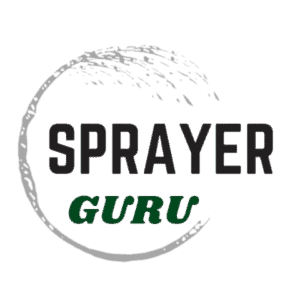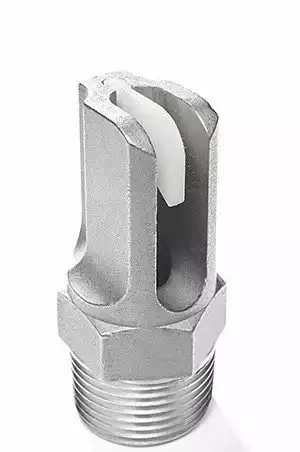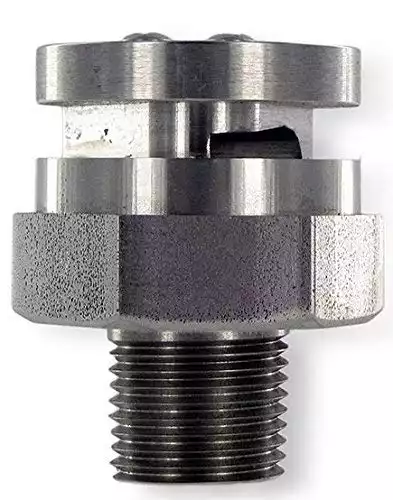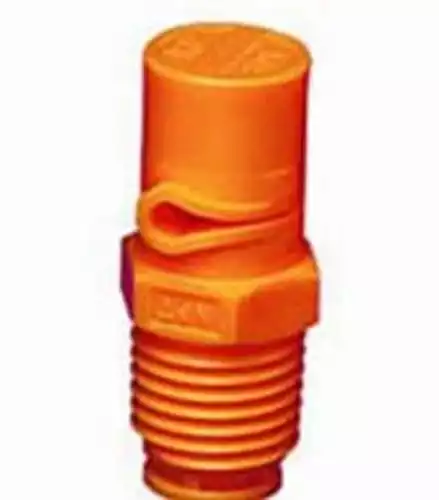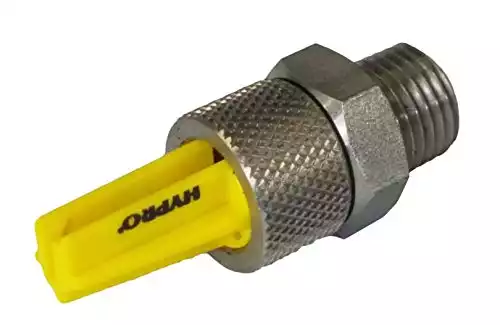A boomless spray nozzle can make life so much easier for anyone who needs to spray rough terrain or navigate around obstacles like trees or fence posts. But there are many different types on the market and you need to know which one will work best for you.
In this post, I am going to lay out how these nozzles differ, and when to use the different types. I will also give you my recommendation for which nozzle is best based on my experience and testing. Read on to discover more!
Understanding Boomless Nozzles
Boomless sprayers work very well for pasture and turf spraying, as well as de-icing, dust control, and right-of-way spraying. While they are less effective in row crop application than a conventional spray boom, they have many advantages over conventional booms. They are easier to maneuver, typically produce larger droplets that minimize drift, require less maintenance, and cost less.
Boomless sprayers use special high-volume sprayer nozzles that cover a wide swath (3-40 ft) with a single nozzle. With them, you can build a sprayer without the need for a conventional boom with numerous spray nozzles.
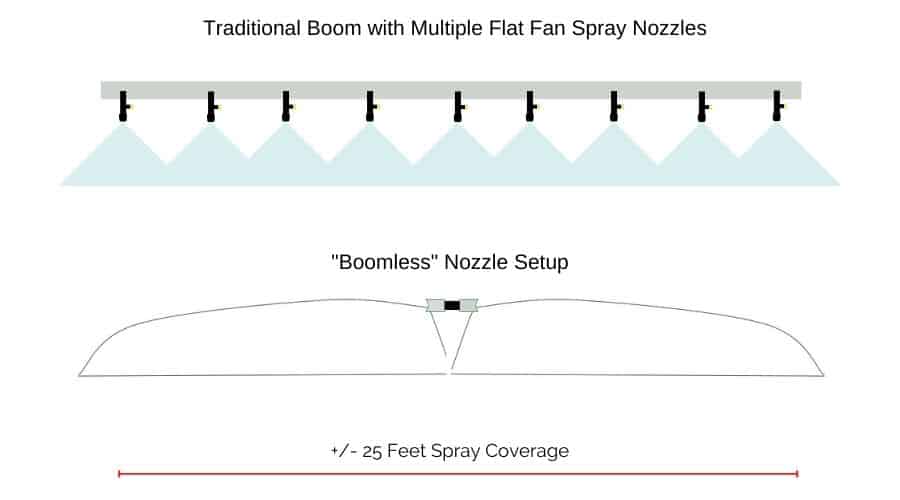
Unlike the flat fan spray nozzles normally found on a boom, these nozzles have a much higher flow rate and cover distances from a few feet up to 40-50 feet when mounted 36 inches above the ground. These nozzles are uniquely designed to give even coverage over the full width of the nozzle’s pattern.
The rest of the sprayer is essentially the same as other sprayers. The type of pump, tank, and overall plumbing used don’t vary much. One difference is that larger boom sprayers may have multiple boom sections controlled by on/off valves, boomless sprayers will just have a valve to turn on and off each individual nozzle.
The key to an effective boomless sprayer is choosing the right nozzle for your needs. So why don’t we take a look at the different types available?
Best Types of Boomless Nozzles
There are many different brands of boomless sprayer nozzles available. They differ in the type of materials they are constructed with, the low they will put out, and their spray pattern. These are four boomless nozzle types that are effective and each one has different strengths and attributes.
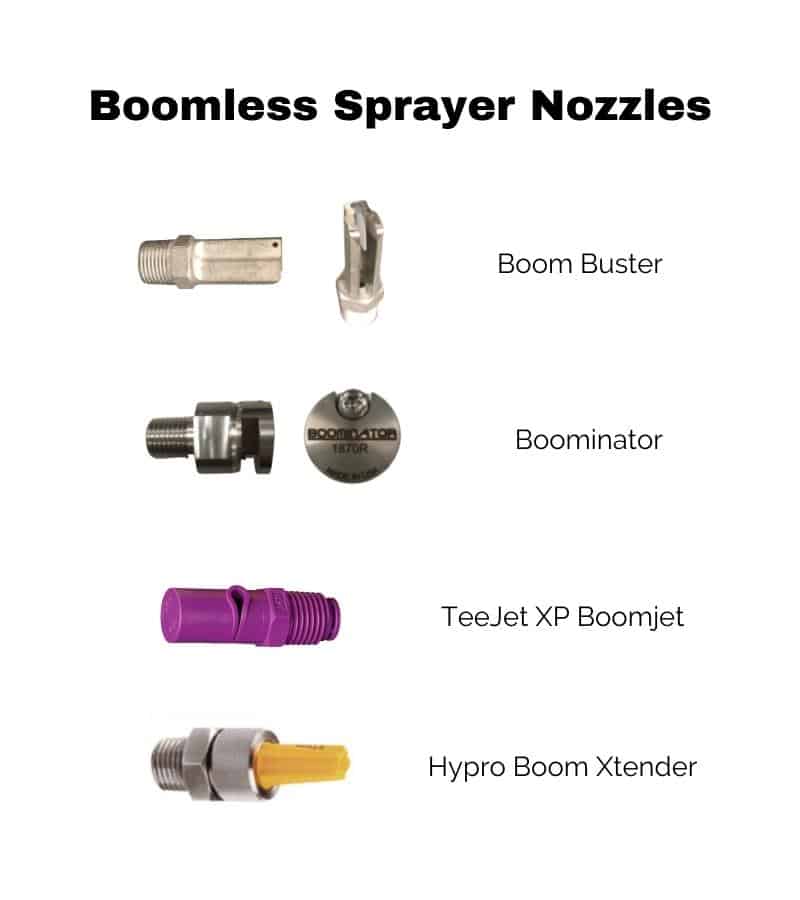
Boom Buster Nozzles
Boom Buster nozzles are also made in the USA from stainless steel. They do have a nylon diffuser that can wear out. A small roll pin holds in this piece. They do not sell the diffuser as a replacement item. You can send them in to be rebuilt by the manufacturer, but there is a charge for this.
Boominator Nozzles
Boominator nozzles are made in the USA. They are made from stainless steel and have a 3-year limited warranty. They do not have any plastic pieces that will wear out. (Boominator does have an economy version of their boomless nozzle that is made of poly/plastic or a combination of metal and plastic.)
The Boominator type boomless nozzle is great for heavy-duty, high-use, applications.
Teejet Boomjet Nozzles
XP BoomJet sprayer nozzles are made of poly/acetal material. It has good resistance to wear and chemical but it is not repairable. These are a good affordable alternative to the Boominator.
Hypro Boom X Tender Nozzles
Boom X Tender nozzles from Hypro are made from a combination of stainless steel and poly. The poly portion can be replaced when it wears out. There is also an all-plastic version of this tip offered. It does not have male national pipe thread instead it has a quarter-turn cap intended to fit on TeeJet and Hypro quick connect nozzle bodies.
Boomless Nozzle Attributes
Here are the different characteristics to consider when choosing a boomless nozzle for your sprayer.
Volume
All of the different boomless spray nozzle manufacturers offer different “size” nozzles meaning they will put out different volumes of liquid. Most range from about 1.5 to 35+ gallons per minute. Each nozzle will have a chart that shows the output in gallons per acre, at various psi. Here is an example:

You can see at 40 PSI this tip would put out a rate of 33 gallons per acre if you are traveling at 10 mph. This tip would cover a width of just 3 feet.
One of the highest flow rates available in a boomless nozzle is the Boom Buster Nozzle 504. It will put out 37 gallons per minute at 50 PSI. One nozzle will cover a distance of up to 40 ft. So with two of these nozzles installed back to back you can cover an 80 ft. swath and apply a rate of 91 gallons per acre at 10 mph.
Spray Width & Pattern
There are 2 main categories of boomless nozzles: conventional and right of way. The “conventional” boomless nozzles are designed to be used in place of a traditional boom, mounted or pulled behind your tractor, ATV, UTV, etc. The Right-of-way nozzle is intended to be mounted on the side of a truck for spraying road ditches.
The key difference is the kickback in the nozzles pattern. Conventional boomless nozzles will have a 15-degree +/- kickback that overlaps when used with its opposite counterpart. Conventional nozzles generally are available in a right or left-hand pattern at the same flow rate. The images below show the difference between these spray patterns:
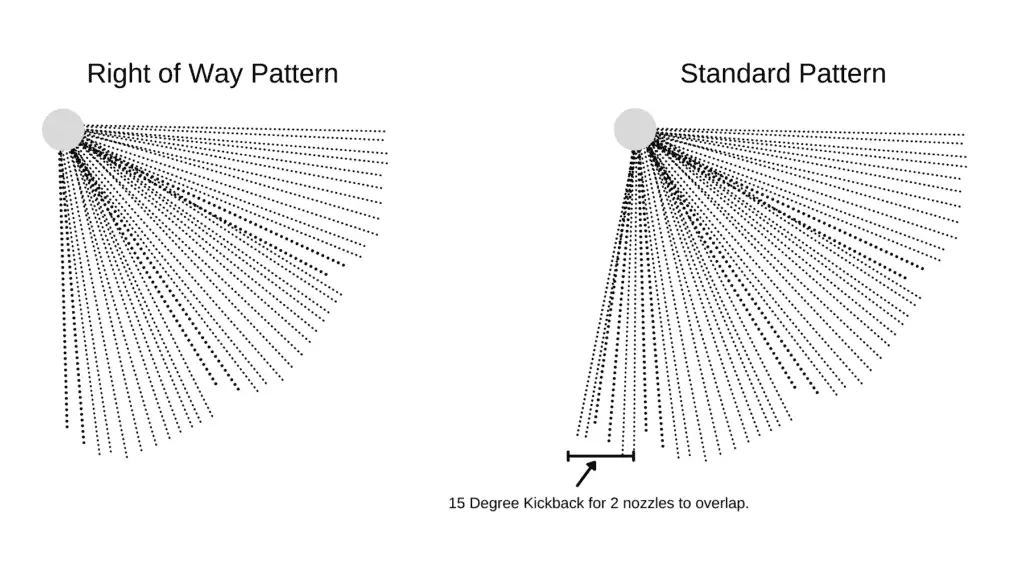


Durability
Wear and chemical resistance are important if you are going to invest in a boomless nozzle. Even if you are just spraying water, friction will wear out the orifice over time. This affects the spray pattern and can alter your flow rate.
How to Mount Boomless Nozzles
All of these boomless nozzles are intended for mounting at a height between 18 and 48 inches. The higher off the ground the nozzle is mounted the greater the width of coverage. The flow charts for these nozzles generally refer to a 36-inch mounting height.
Some of the specific size nozzles such as the Boom Buster 180-6 have directions to mount the nozzle facing slightly downward. Other sizes are intended to be mounted level with the ground. Some of the larger nozzles actually need to be mounted with the nozzle slightly upward in order to get maximum coverage.
The mounting orientation is not the same for these boomless nozzles. While they all have male national pipe thread inlets, the spray pattern may be inline or perpendicular to the inlet. Keep this in mind when mounting on your sprayer.

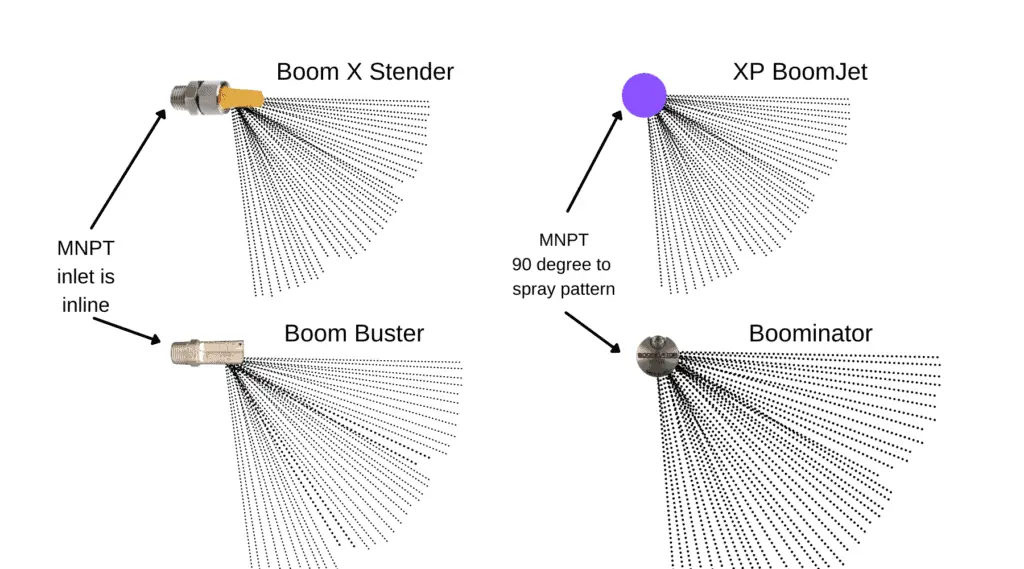
Boomless Nozzle Mounting Kits
Unlike a traditional boom, you do not need a boom pipe to clamp all of your nozzles. You don’t need nozzle bodies, caps, gaskets, etc. The nozzles can be mounted about as simple as you want.
Some of the manufacturers of boomless nozzles offer mounting kits, but you can mount these nozzles without them. It will require just a few plumbing fittings.
Depending on the spray pattern orientation (see above) you can run your supply hose directly to the nozzle inlet. If you are using two nozzles in tandem, then they can be mounted back to back in a “tee” fitting. You may need to use street elbows or similar fittings to get your nozzles directed where you want.
With the Boom X Tender and Boom Buster nozzles, they would only require a tee. The Boominator brand and the XP BoomJet will need a 90-degree elbow in addition to the “tee”, to mount them in the correct orientation.

Boomless Nozzle Price Comparison
Boomless nozzles are not inexpensive, but when you consider what they can replace in terms of a traditional spray boom, you can save a lot of money. They won’t work for all applications but they are becoming more popular for good reason.
Each brand has multiple flow rates and swath widths available. Here is the approximate cost range for a single nozzle:
| Brand | Min Cost | Max Cost |
| Boominator | $70 | $160 |
| Boom Buster | $90 | $170 |
| BoomJet | $30 | $45 |
| Boom X Tender | $70 | $105 |
Boomless Nozzle Recommendations
For heavy-use commercial and ag applications, you will want to use either the Boom Buster or Boominator nozzles. If you are looking for an inexpensive fence row nozzle that will work with the quarter-turn style nozzle bodies on your sprayer then the Hypro Fast Cap Boom X Tender is a great option. Lighter-use lawn sprayers can get by with the Teejet XP Boomjet. It has an even pattern and you don’t have to spend as much as you would for its stainless counterparts.
I have been using the TeeJet XP Boomjet boomless nozzles on my property for a few years. I like that they have 1/4 inch male pipe thread. This makes them easy to install on the QuickJet nozzle bodies.
I use them with a 1/4 Mpt x QuickJet Adapter so that I can switch from my boomless nozzles to other standard flat fan nozzles if needed. You can see in the video below the type of droplet and pattern they produce as well as how they mount. The adapter keeps them aligned perfectly.
Whatever type of boomless nozzle you choose, remember there are different nozzle sizes and spray distances. Also, be sure to order both a “left” and a “right” nozzle for the brands that require it like the Boominator and Teejet nozzles.
Conclusion
Boomless sprayers do work well in many applications. However, it is important to note they do not provide coverage as uniform as a boom sprayer. If your application requires the most precise and uniform coverage available, you will likely still need a boom with multiple nozzles.
They also work best when you stay within their intended operating pressure. Each nozzle will have its own application chart that shows the flow rates that can be achieved at certain pressures. Going outside of these pressure ranges will give you either an uneven pattern or less coverage.
The bottom line is that boomless sprayers do work in many applications, just make sure you size the correct nozzles for the job.
